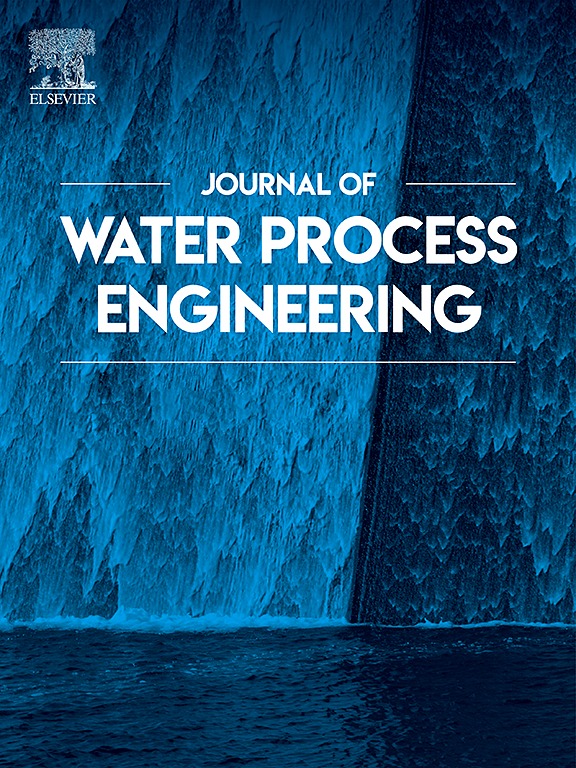Prediction and optimization of key factors for catalytic O3 degradation of antibiotics based on Catboost model coupled Bayesian optimisation algorithm
IF 6.3
2区 工程技术
Q1 ENGINEERING, CHEMICAL
引用次数: 0
Abstract
Machine learning (ML) has the ability to improve the efficiency of heterogeneous catalytic ozone (O3) degradation of antibiotics through the potential for rapid identification of key factors in the catalytic system. However, there is still a lack of research on the reverse regulation of catalyst metal composition and reaction conditions for specific antibiotics. This study combined ML model and the Bayesian Optimization Algorithm (BOA) to predict and optimize the key influencing factors in the catalytic O3 degradation of antibiotic systems. The results indicate that the CatBoost model presented the optimal training efficiency and accuracy, with an R2 value of 0.9482 and an RMSE of 0.0401. SHAP analysis revealed that antibiotic type, catalyst metal composition, and O3 flow rate are the three most critical features in model training, with significant interactions observed between O3 flow rate, pH, and catalyst dosage. Experimental validation demonstrated that the experimental TOC removal rate of antibiotics reached 87.33 % under optimized conditions, while the model-optimized TOC removal rate achieved 90 %, with an error of only 2.97 %. The present work significantly improved the efficiency and accuracy of O3 catalytic degradation process design for antibiotics and provided a novel approach for selecting and predicting reaction parameters in O3 catalytic degradation of specific antibiotics.

机器学习(ML)可以快速识别催化系统中的关键因素,从而提高臭氧(O3)异相催化降解抗生素的效率。然而,对于特定抗生素的催化剂金属成分和反应条件的反向调节,目前仍缺乏研究。本研究结合 ML 模型和贝叶斯优化算法(BOA)预测并优化了抗生素体系催化 O3 降解的关键影响因素。结果表明,CatBoost 模型具有最佳的训练效率和准确性,R2 值为 0.9482,RMSE 为 0.0401。SHAP 分析表明,抗生素类型、催化剂金属成分和 O3 流量是模型训练中最关键的三个特征,O3 流量、pH 值和催化剂用量之间存在显著的交互作用。实验验证表明,在优化条件下,抗生素的实验 TOC 去除率达到 87.33%,而模型优化后的 TOC 去除率达到 90%,误差仅为 2.97%。本研究大大提高了抗生素 O3 催化降解工艺设计的效率和准确性,为特定抗生素 O3 催化降解反应参数的选择和预测提供了一种新方法。
本文章由计算机程序翻译,如有差异,请以英文原文为准。
求助全文
约1分钟内获得全文
求助全文
来源期刊

Journal of water process engineering
Biochemistry, Genetics and Molecular Biology-Biotechnology
CiteScore
10.70
自引率
8.60%
发文量
846
审稿时长
24 days
期刊介绍:
The Journal of Water Process Engineering aims to publish refereed, high-quality research papers with significant novelty and impact in all areas of the engineering of water and wastewater processing . Papers on advanced and novel treatment processes and technologies are particularly welcome. The Journal considers papers in areas such as nanotechnology and biotechnology applications in water, novel oxidation and separation processes, membrane processes (except those for desalination) , catalytic processes for the removal of water contaminants, sustainable processes, water reuse and recycling, water use and wastewater minimization, integrated/hybrid technology, process modeling of water treatment and novel treatment processes. Submissions on the subject of adsorbents, including standard measurements of adsorption kinetics and equilibrium will only be considered if there is a genuine case for novelty and contribution, for example highly novel, sustainable adsorbents and their use: papers on activated carbon-type materials derived from natural matter, or surfactant-modified clays and related minerals, would not fulfil this criterion. The Journal particularly welcomes contributions involving environmentally, economically and socially sustainable technology for water treatment, including those which are energy-efficient, with minimal or no chemical consumption, and capable of water recycling and reuse that minimizes the direct disposal of wastewater to the aquatic environment. Papers that describe novel ideas for solving issues related to water quality and availability are also welcome, as are those that show the transfer of techniques from other disciplines. The Journal will consider papers dealing with processes for various water matrices including drinking water (except desalination), domestic, urban and industrial wastewaters, in addition to their residues. It is expected that the journal will be of particular relevance to chemical and process engineers working in the field. The Journal welcomes Full Text papers, Short Communications, State-of-the-Art Reviews and Letters to Editors and Case Studies
 求助内容:
求助内容: 应助结果提醒方式:
应助结果提醒方式:


